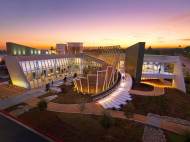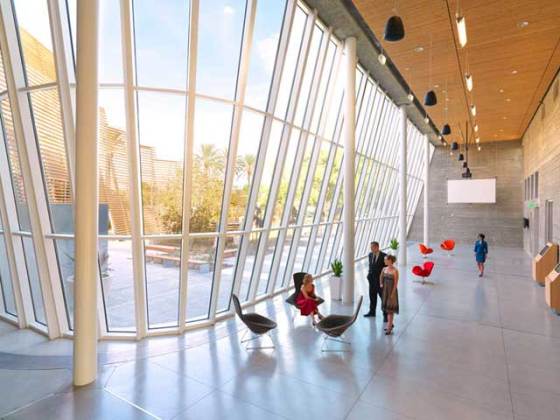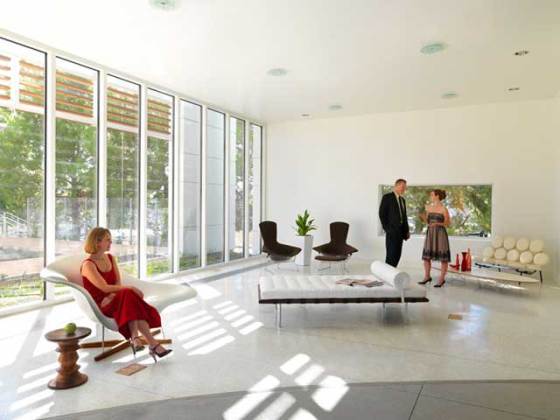Green architecture – Frontier Project
 Located in Rancho Cucamonga, California, the Frontier Project displays and utilizes sustainable innovations for Southern California living and working environments. Designed by HMC Architects, the building is a 1,300-square-meter (14,000-square-foot) demonstration of how sustainable design can be economical, efficient, and inviting. The Frontier Project’s goal is to educate resident consumers, commercial builders, and sustainable advocates about the methods and technologies in water, energy, and site conservation.
Located in Rancho Cucamonga, California, the Frontier Project displays and utilizes sustainable innovations for Southern California living and working environments. Designed by HMC Architects, the building is a 1,300-square-meter (14,000-square-foot) demonstration of how sustainable design can be economical, efficient, and inviting. The Frontier Project’s goal is to educate resident consumers, commercial builders, and sustainable advocates about the methods and technologies in water, energy, and site conservation.
The Frontier Project features a rooftop deck where visitors can view the green roof and photovoltaic technologies at use in the building, a demonstration kitchen and living room that highlight water and energy efficient appliances, recycled content carpet, flooring, countertops, and cabinets, a passive cooling system, reclaimed redwood from a local winery, an onsite water retention system, and California Native plants and succulents. Carpet tiles with a pre-consumer and post-consumer content are used throughout the Frontier Project. Homeowners, builders, and business owners are invited to view these systems to learn how to incorporate them into their homes or businesses. Information is available on each building component, including how they work and their environmental impact.
The Frontier Project utilized waste reduction practices on the construction site, to reduce and manage construction waste, diverting approximately 85% of its construction waste from the landfill. Additionally, every consideration was given to the amount of materials needed with the goal to use materials that have less of an environmental impact where possible. Salvaged redwood from a local winery is used as a shade structure on the facade of the building. This material is reused and local, reducing the environmental impacts that result in the transportation of materials and products to the construction site.
Water efficient restrooms feature water-free urinals, bathroom wall tiles that are 50% pre-consumer recycled content, flow faucets, and automatic flush low-flow toilets. Low-water use and California Friendly plants require very little water or maintenance. Subsurface drip irrigation lines are used, to maximize water efficiency. The Frontier Project one acre site features a bioswale that directs all onsite water to a 7 570 liter (2,000 gallon) underground cistern, and 190,000 liter (50,000 gallon) infiltration basin. This water is used to irrigate plants onsite.
Concrete walls and flooring benefit from fly ash- 25% in walls and 40% in floors- a coal-manufacturing by-product that would otherwise end up in a landfill. All exterior walls of the Frontier Project are comprised of Insulated Concrete Forms (ICF’s). The world’s largest energy users are commercial buildings. They require a substantial amount of energy to maintain comfortable temperatures within their walls. One way to reduce commercial building energy consumption is to insulate walls to reduce the amount of energy needed to heat or cool a building. Insulated Concrete Forms (ICF’s) are a product used in place of standard pour in place concrete walls. ICF’s are stacked in place, similar to how Lego blocks stack.
The ICF’s walls are made from Styrofoam, or expanded polystyrene, which acts as a thermal mass on either side of the concrete that is poured in between the Styrofoam. The walls of the ICF are, connected by engineered webs made from recycled industrial polypropylene plastic. The webs make the concrete walls stronger and allow greater accessibility for builders in the construction process. The benefits of using ICF include energy efficiency, excellent air quality, and a reduction in construction waste.
The ARXX ICF’s being used in the Frontier Project construction consist of 47% recycled material and are listed as a Green Building product. The average energy savings resulting from ICF use is 46% compared to the energy use of a standard wood frame structure.











Leave your response!